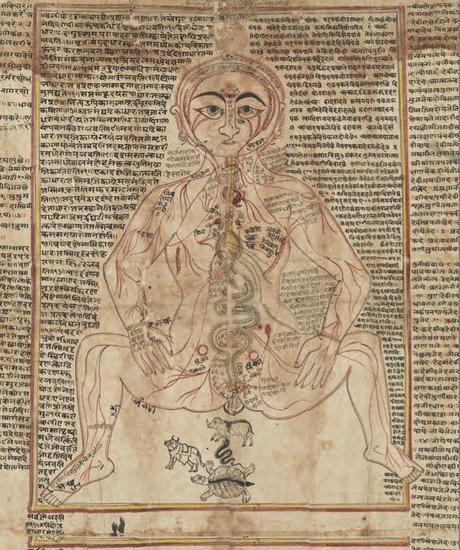
Anatomical Body
India, Gujarat, 18th century
As I mentioned in my post Svadhyaya (Self-Study), Part 1, there are two different interpretations of the meaning of niyama svadhyaya (self-study). In his book The Yoga Sutras of Patajanli, Edwin Bryant says:
Svadhyaya literally means self-study, but it more commonly refers to the study of sacred texts (in a sense the two meanings overlap, since sacred texts typically teach about the self).
So while one meaning of svadhyaya is to cultivate your inner witness to study your own self as I wrote about my first post earlier this week, another is to study the yoga scriptures, such as the Bhagavad Gita and The Yoga Sutras, and—if you’re feeling brave—the Vedas and Upanishads. And this type of study complements your self-study because as you read these texts, you can reflect how to use the knowledge they contain. I consulted with Ram before writing my posts on svadhyaya’s two different meanings, and he recommended asking yourself these questions about the scriptures:
- How do you use the knowledge for self-empowerment?
- How do you use the knowledge for the betterment of society?
- How do you grow in body and mind after reading those scriptures?
S(s)vadhyaya =education, study, or knowledge improvement that is gained from studying not just scriptures but any book or any experience that provides deep meaning or interpretation of life (that is, thought provoking).
So svadhyaya includes any books about yoga, whether books that interpret the scriptures, such as the Edwin Bryant book I mentioned above (which I frequently turn to), books about the history of yoga, such as Georg Feuerstein’s The Yoga Tradition about ancient yoga and Yoga Body: The Origins of Modern Posture Practice by Mark Singleton about modern yoga, or modern books about yoga (plus, our blog, of course). Obviously, texts from the religions of the world will also provide you with food for thought, but you should also consider psychology books and books about human behavior. Two of the non-fiction books that have influenced me greatly include Full Catastrophe Living by Jon Kabat-Zinn and A General Theory of Love by Thomas Lewis, Fari Amini, and Richard Lannon. Even fiction that explores the human condition can contribute to your self-study (I read an interesting New York Times article For Better Social Skills, Scientists Recommend a Little Chekhov that explained how literary fiction can help you develop empathy and improve your understanding of human behavior).
It makes a lot of sense that in our studies of the self, we should turn to the wisdom of others. After all, yogis and people of other cultures worldwide have been engaged in self-study for centuries, so we can learn a tremendous amount from their experiences. As a matter of fact, the single piece of yogic wisdom that I keep returning to in my everyday life is over two thousand years old:
The wise man lets go of allresults, whether good or bad,and is focused on the action alone.Yoga is skill in actions.—Bhagavad GitaBrad and I have been talking about that quote a lot lately because he has been taking on some big challenges at work and he finds that taking this yogic approach has helped him maintain some peace of mind. (And, yes, I do remember that I include that quote that in my posts all the time!)Subscribe to YOGA FOR HEALTHY AGING by Email ° Follow Yoga for Healthy Aging on Facebook

